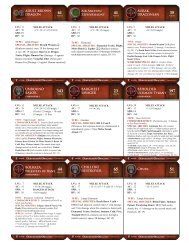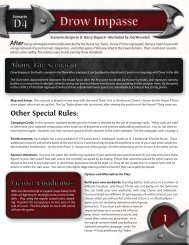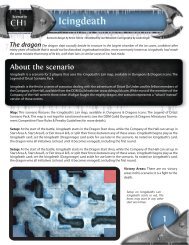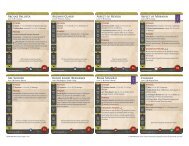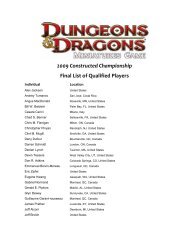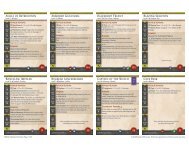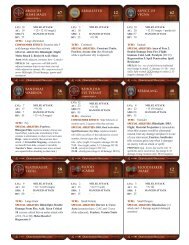You also want an ePaper? Increase the reach of your titles
YUMPU automatically turns print PDFs into web optimized ePapers that Google loves.
Leap (Replaces attacks: make a single melee attack at +[#], [#] damage) Earlier printings of this<br />
ability didn’t note that it launched a single melee attack.<br />
Level (Save): (Creature Statistic) Add this number to the die roll whenever a creature makes a<br />
save. This statistic is sometimes referred to as “level.”<br />
In previous editions of the <strong>rules</strong>, stat cards listed Save +/– [#] or Save = [#] as special abilities<br />
instead of a Level (Save) number.<br />
Level Drain (Whenever this creature’s melee attack deals damage to a living creature, the<br />
damaged creature gets attack –1 and save –1, and this creature gets +5 hp) The hit points<br />
gained by this ability stack with themselves.<br />
Life Drain [#] (If target is a living creature, this creature gets +[#] hp [maximum [#] hp]) The hit<br />
points gained by this ability stack with themselves, to the listed maximum.<br />
Limited format: In a league or tournament, this refers to battles between warbands composed<br />
of creatures drawn from a small pool of miniatures. Unlike Out of the Box, in some Limitedformat<br />
skirmishes players do not use all the creatures in their pools to build their warbands.<br />
Such games allow access to summon spells and abilities such as Minions that put new<br />
creatures onto the battle map, if a player’s pool includes qualified creatures that are not part<br />
of his or her warband. Out of the Box and other Limited formats don’t observe the 70% limit<br />
for the cost of a creature. Thus, a creature costing more than 70 points can be part of a 100-<br />
point Limited warband, and a creature that costs more than 140 points can be part of a 200-<br />
point Limited warband.<br />
line 12: (Range) A spell or effect with a range of<br />
line 12 affects creatures in a straight line away<br />
from the acting creature toward the nearest<br />
enemy or ally. A line does not affect creatures<br />
more than 12 squares away. Trace a line from<br />
a corner of a square in the acting creature’s<br />
space to a different corner of a square in the<br />
target creature’s space. The line affects all<br />
squares that the line goes through or touches<br />
until it touches or crosses terrain that blocks<br />
line of effect. (Don’t count the corner where<br />
the line starts.) The line continues to its full<br />
range, usually going past the target and<br />
possibly affecting more creatures. The same<br />
corner can’t be chosen for both the starting<br />
point and the target of the effect.<br />
line of effect: Line of effect is nearly always the<br />
same as line of sight (see below). A few<br />
special effects, such as wall of force, block line<br />
of effect: They prevent attacking or affecting a<br />
space with special abilities and spells, but they<br />
do not block line of sight to that space.<br />
line of sight: Two creatures have line of sight to<br />
each other unless walls are in the way. If you<br />
can trace even a single line between two<br />
creatures that doesn’t touch a wall, they have<br />
line of sight to each other. See the diagram on<br />
page 15.<br />
Certain effects, such as forest terrain or<br />
Invisible, also prevent line of sight.<br />
living: All creatures are living, except for Construct and Undead creatures.<br />
39



